Aug 23, 2010
Climate Change: Concocting the “Consensus”
By Andrew Gavin Marshall
The debate is over! There is a consensus! The time for discussion has ended and the need for action is paramount! We have all heard this before.
Yet it is important to keep in mind that these types of statements are inherently inimical to scientific inquiry; the debate and discussion should never be over. As new information surfaces, it should be taken into consideration, analyzed, discussed, debated and ultimately it will aid in the advancement of knowledge and scientific understanding. To declare the debate as over is to declare information and knowledge as irrelevant. Progress has never come from holding onto antiquated ideas. The attainment of knowledge does not come from the refusal to reflect. Climate change is no exception. In light of events of the past year, it has become clear that there was a concerted effort on the part of a small clique of elite scientists at the UN and in supporting institutions, governments and universities to concoct the climate change “consensus” to pressure governments and public opinion into supporting the political, economic and social agenda of elites.
This article is a brief examination of the transformation of a political consensus into a scientific consensus, and thus we see that the scientific realm of inquiry and pursuit of knowledge and truth is not, itself, outside the influence of political, economic and social power structures. Indeed, science being a comparatively new concept in the human experience (roughly 350 years old) has historically been co-opted by entrenched elites to further their own interests and to strengthen their own power. The scientific technique becomes the elite technique; discovery becomes domination; knowledge becomes power; and truth becomes trite.
In November of 2009, the Climategate scandal broke, in which thousands of emails written by scientists at the University of East Anglia’s Climatic Research Unit (CRU) were leaked and revealed a concocted effort to skew the data and prevent dissenting views from getting into peer reviewed academic journals. In short, it was institutionalized intellectual dishonesty. The academics involved in the scandal were “the small group of scientists who have for years been more influential in driving the worldwide alarm over global warming than any others, not least through the role they play at the heart of the UN’s Intergovernmental Panel on Climate Change (IPCC)”:
Professor Philip Jones, the CRU’s director, is in charge of the two key sets of data used by the IPCC to draw up its reports. Through its link to the Hadley Centre, part of the UK Met Office, which selects most of the IPCC’s key scientific contributors, his global temperature record is the most important of the four sets of temperature data on which the IPCC and governments rely - not least for their predictions that the world will warm to catastrophic levels unless trillions of dollars are spent to avert it.
Dr Jones is also a key part of the closely knit group of American and British scientists responsible for promoting that picture of world temperatures conveyed by Michael Mann’s “hockey stick” graph which 10 years ago turned climate history on its head by showing that, after 1,000 years of decline, global temperatures have recently shot up to their highest level in recorded history.
Given star billing by the IPCC, not least for the way it appeared to eliminate the long-accepted Mediaeval Warm Period when temperatures were higher they are today, the graph became the central icon of the entire man-made global warming movement.[1]
Further, these scientists (as the emails revealed) conspired to prevent their data from being released through freedom of information laws, and “have come up with every possible excuse for concealing the background data on which their findings and temperature records were based."[2]
Many of the emails revealed “strenuous efforts by the mainstream climate scientists to do what outside observers would regard as censoring their critics. And the correspondence raises awkward questions about the effectiveness of peer review - the supposed gold standard of scientific merit - and the operation of the UN’s top climate body, the Intergovernmental Panel on Climate Change (IPCC).” Professor Jones had written emails in 2004 to climate scientist Michael Mann (who pioneered the “hockey stick graph") explaining that he rejected two articles he was peer reviewing that had called into question conclusions made by the Climatic Research Unit he ran at East Anglia. Emails were also sent back and forth lambasting the journal ‘Climate Research’ for publishing skeptical articles, suggesting that they encourage colleagues to no longer submit papers to, or cite papers in the journal. Michael Mann made this suggestion in 2003 following the journal’s publication of an article which refuted his “hockey stick” graph, written by two Harvard astrophysicists, who wrote that, “the 20th century is neither the warmest century over the last 1,000 years, nor is it the most extreme.” Phil Jones and Trenberth, another scientist at the CRU, were joint lead authors for a major chapter in the IPCC report, and as one email revealed, they were planning to keep skeptic articles out of the report, “I can’t see either of these papers being in the next IPCC report. Kevin [Trenberth] and I will keep them out somehow - even if we have to redefine what the peer review literature is!"[3] So much for intellectual honesty and ‘consensus’.
Following the Climategate controversy, one scandal after another revealed the poor record of intellectual honesty and extreme lack of scientific documentation that was put into the UN’s IPCC report, which was (along with Al Gore) the recipient of the 2007 Nobel Peace Prize, and when published led to the media and governments around the world proclaiming the debate to be over and the science settled. The falsities range from incorrectly stating that over 55% of the Netherlands is under sea level (and thus susceptible to flooding), when in fact only 26% is below seal level,[4] to more serious and relevant claims upon which the whole consensus is built, such as the notion of the climate warming.
Phil Jones, the scientist at the center of the Climategate scandal and head of the University of East Anglia’s Climatic Research Unit (CRU), admitted in February of 2010 that, “he has trouble ‘keeping track’ of the information,” and that his data for the vital “hockey-stick graph” showing increasing warming may have “gone missing.” He further had to concede that the earth “may have” been warmer in the medieval warm period than it is today, and that “for the past 15 years there has been no ‘statistically significant’ warming.” Jones continued in explaining the warming issue with the employment of Orwellian double-speak:
He also agreed that there had been two periods which experienced similar warming, from 1910 to 1940 and from 1975 to 1998, but said these could be explained by natural phenomena whereas more recent warming could not.
He further admitted that in the last 15 years there had been no ‘statistically significant’ warming, although he argued this was a blip rather than the long-term trend.[5]
So, while he admits that “similar” warming periods in the past were caused by natural phenomena, the current warming is caused by man, and yet he concedes that there has been “no statistically significant” current warming. In other words, past warming can be attributed to natural changes, while the warming that hasn’t taken place can be attributed to man.
While the 2007 UN IPCC report stated that the evidence of warming is “unequivocal,” John Christy, professor of atmospheric science at the University of Alabama in Huntsville, and a former lead author on the IPCC, stated that, “The temperature records cannot be relied on as indicators of global change.” Why is this the case?
The doubts of Christy and a number of other researchers focus on the thousands of weather stations around the world, which have been used to collect temperature data over the past 150 years. These stations, they believe, have been seriously compromised by factors such as urbanisation, changes in land use and, in many cases, being moved from site to site.[6]
Christy, who has published several papers on this subject, looking at various weather stations around the world, concluded that, “the popular data sets show a lot of warming but the apparent temperature rise was actually caused by local factors affecting the weather stations, such as land development.” Ross McKitrick, professor of economics at the University of Guelph, Canada, who was invited by the IPCC to review its last report, stated that, “We concluded, with overwhelming statistical significance, that the IPCC’s climate data are contaminated with surface effects from industrialisation and data quality problems. These add up to a large warming bias."[7] Even more scandals broke out in regards to the UN IPCC report:
The report falsely claimed that Himalayan glaciers would disappear by 2035 when evidence suggests that they will survive for another 300 years. It also claimed that global warming could cut rain-fed North African crop production by up to 50 per cent by 2020. A senior IPCC contributor has since admitted that there is no evidence to support this claim.[8]
Further, Rajendra Pachauri, the Chairman of the IPCC, “was told that the Intergovernmental Panel on Climate Change assessment that the glaciers would disappear by 2035 was wrong, but he waited two months to correct it. He failed to act despite learning that the claim had been refuted by several leading glaciologists."[9] The scientist at the IPCC who was behind the glacier claim was “well aware” that the claim “did not rest on peer-reviewed scientific research,” and that, “it was included purely to put political pressure on world leaders."[10]
Robert Watson, former Chairman of the IPCC stated that, “The mistakes all appear to have gone in the direction of making it seem like climate change is more serious by overstating the impact. That is worrying. The IPCC needs to look at this trend in the errors and ask why it happened."[11]
The IPCC report had “stated that observed reductions in mountain ice in the Andes, Alps and Africa was being caused by global warming, citing two papers as the source of the information.” However, as was later revealed, “one of the sources quoted was a feature article published in a popular magazine for climbers which was based on anecdotal evidence from mountaineers about the changes they were witnessing on the mountainsides around them,” and “the other was a dissertation written by a geography student, studying for the equivalent of a master’s degree, at the University of Berne in Switzerland that quoted interviews with mountain guides in the Alps.” As for the source of information regarding the Himalayas melting, the citation indicated a non-peer reviewed report put out by the World Wildlife Fund (WWF), and further, “the IPCC report made use of 16 non-peer reviewed WWF reports."[12]
Dr. Andrew Lacis, a physicist with the NASA Goddard Institute for Space Studies, submitted a comment to the IPCC in regards to the Executive Summary of Chapter 9, which was the chapter that concluded that climate change is man-made. His comment was ultimately rejected to be included in the IPCC report. He wrote: There is no scientific merit to be found in the Executive Summary. The presentation sounds like something put together by Greenpeace activists and their legal department. The points being made are made arbitrarily with legal sounding caveats without having established any foundation or basis in fact. The Executive Summary seems to be a political statement that is only designed to annoy greenhouse skeptics. Wasn’t the IPCC Assessment Report intended to be a scientific document that would merit solid backing from the climate science community - instead of forcing many climate scientists into having to agree with greenhouse skeptic criticisms that this is indeed a report with a clear and obvious political agenda. Attribution can not happen until understanding has been clearly demonstrated. Once the facts of climate change have been established and understood, attribution will become self-evident to all. The Executive Summary as it stands is beyond redemption and should simply be deleted.[13]
Dr. John Christy, the former lead author of the IPCC in 2001 for the 3rd assessment report (the fourth was the recent one released in 2007), stated that he personally witnessed UN scientists scheming to exaggerate claims, “I was at the table with three Europeans, and we were having lunch. And they were talking about their role as lead authors. And they were talking about how they were trying to make the report so dramatic that the United States would just have to sign that Kyoto Protocol."[14] In other words, the plan was to use fear tactics to manipulate reluctant nations (and presumably public opinion) into supporting the UN’s political agenda.
Australian climate policy analyst and editor of the journal, Energy & Environment, Sonja Boehmer-Christiansen, spoke at length to the British Parliamentary inquiry into the climategate scandal, in which she explained how climate science was corrupted by money: I was peer reviewer for IPCC (Intergovernmental Panel on Climate Change)… Since 1998 I have been the editor of the journal, Energy & Environment (E&E) published by Multi-science, where I published my first papers on the IPCC. I interpreted the IPCC “consensus” as politically created in order to support energy technology and scientific agendas that in essence pre-existed the “warming-as -man-made catastrophe alarm.”
Scientific research as advocacy for an agenda (a coalition of interests, not a conspiracy,) was presented to the public and governments as protection of the planet… CRU, working for the UK government and hence the IPCC, was expected to support the hypothesis of man-made, dangerous warming caused by carbon dioxide, a hypothesis it had helped to formulate in the late 1980s…
In persuading policy makers and the public of this danger, the “hockey stick” became a major tool of persuasion, giving CRU a major role in the policy process at the national, EU and international level. This led to the growing politicisation of science in the interest, allegedly, of protecting the “the environment” and the planet. I observed and documented this phenomenon as the UK Government, European Commission, and World Bank increasingly needed the climate threat to justify their anti-carbon (and pro-nuclear) policies. In return climate science was generously funded and required to support rather than to question these policy objectives… Opponents were gradually starved of research opportunities or persuaded into silence. The apparent “scientific consensus” thus generated became a major tool of public persuasion…
The CRU case is not unique. Recent exposures have taken the lid off similar issues in the USA, the Netherlands, Australia, and possibly in Germany and Canada… It is at least arguable that the real culprit is the theme- and project-based research funding system put in place in the 1980s and subsequently strengthened and tightened in the name of “policy relevance”. This system, in making research funding conditional on demonstrating such relevance, has encouraged close ties with central Government bureaucracy. Some university research units have almost become wholly-owned subsidiaries of Government Departments. Their survival, and the livelihoods of their employees, depends on delivering what policy makers think they want. It becomes hazardous to speak truth to power.[15]
While this is not by any means a conclusive or expansive analysis of the problems with climate science and the manufacture of consensus, let alone the facts of climate change itself, it is indicative of a directed effort on the part of political and economic powers to influence and shape a scientific “consensus” to fit in with their own political and economic agenda. This is the dangerous road taken when the state legitimizes particular sciences and more importantly, particular scientific views. When the state has decided upon its position (not to mention major financial and philanthropic interests), money flows only to those that support the state’s position. President Eisenhower warned the world about this in his 1961 farewell address to the nation, in which he not only warned about the dangerous threat to democracy posed by the “military-industrial complex”, but also of another grave threat:
Today, the solitary inventor, tinkering in his shop, has been overshadowed by task forces of scientists in laboratories and testing fields. In the same fashion, the free university, historically the fountainhead of free ideas and scientific discovery, has experienced a revolution in the conduct of research. Partly because of the huge costs involved, a government contract becomes virtually a substitute for intellectual curiosity. For every old blackboard there are now hundreds of new electronic computers. The prospect of domination of the nation’s scholars by Federal employment, project allocations, and the power of money is ever present – and is gravely to be regarded. Yet, in holding scientific research and discovery in respect, as we should, we must also be alert to the equal and opposite danger that public policy could itself become the captive of a scientific-technological elite.[16]
While science can reveal great truths and important knowledge to be used in the advancement of the human species and human society, so too can it be used against human society and the human species. So long as the malevolent power structures of the political, economic and social world remain and grow, scientific technique and discovery will be co-opted by the elites that control the global apparatus of power in an effort to better secure and strengthen their power. Without a change in the global power structures and nature of human civilization, science will be used against the people. We cannot expect truth and progress from a deceptive and oppressive global system. To find truth in the scientific world, we must simultaneously seek truth in the political, economic and social worlds. Progress in one sphere must entail progress in all spheres; without that, we leave ourselves vulnerable to the same weaknesses prevalent in all human institutions. Science is subject to human interpretation, and if we have learned one thing about human nature from all of our collective history, it can be said that humans are deeply flawed, most especially when power comes into play. The quest for all truth is the quest to challenge all power.
Andrew Gavin Marshall is a Research Associate with the Centre for Research on Globalization (CRG), and is studying Political Economy and History in Canada. He is co-editor, with Michel Chossudovsky, of the recent book, “The Global Economic Crisis: The Great Depression of the XXI Century,” available to order at Globalresearch.ca.
Aug 20, 2010
Challenges and innovation in agriculture
The Scientific Alliance Newsletter
The Royal Society has done us all a service by making freely available a special issue of the Philosophical Transactions on the theme ‘Food Security: feeding the world in 2050’. 21 articles cover a wide range of issues, from population and food consumption trends, through crop, livestock and fishery yields to other important factors such as globalization, water availability and waste. Coincidentally, a few months ago, the neighbouring Royal Academy of Engineering published a report on ‘Global Water Security - an engineering perspective’. Since farming is reckoned to consume about 70% of available fresh water globally, this is one of the key issues underpinning food security.
The Royal Society publication is particularly valuable in providing a broad overview of a key issue which is vital to our continuing prosperity. The price effect of Russia’s recent effective ban on grain exports was dramatic. Although this might be seen as an overreaction by the market, given that the supply situation is nowhere near as bad as that which led to the steep rises in 2008, it is yet another illustration of the vital nature of food security. We in the prosperous North take it for granted, but minor crises like this provide a salutary lesson: take away an assured and affordable food supply and our day-to-day priorities change dramatically. If things were to get really bad, modern societies would simply not be able to function. Things may have changed a lot since the days of hunter/gathering communities, but that simple fact remains the same.
Given the range of views on the future of the food supply - from the neo-Malthusians who still believe the high productivity necessary to sustain the current population is unsustainable, through advocates of low-input, extensive farming which is promoted as the solution, if we would only all become vegetarians, to agronomists who see no reason why plant breeding should not continue to deliver the yield increases necessary - it is good to see an objective scientific assessment.
Keith Jaggard and colleagues from Rothamsted Research consider a world of 9.1 billion people, with atmospheric carbon dioxide at 550ppm, ozone at 60ppb and average temperatures 2C higher. Given the recent failure of the global climate to conform to the pattern modelled by the IPCC, this temperature may be a significant overestimate, but nonetheless is still the received wisdom. Under this scenario, many crops (but not C4 ones) would see a yield increase of 13% due to carbon dioxide fertilisation, partly offset by a 5% decline because of higher ozone levels.
They also see opportunities for increased yields from projected temperature increases in some areas, with the most difficult challenge coming from soil pathogens, for which they foresee transgenic solutions. On top of this, there is still a significant yield gap between what the average farmer harvests and the best local benchmark. Even in efficient intensive farming systems this may be 20%; in developing countries it is usually much bigger, but more easily bridged via better fertilisation and crop protection. Overall, their conclusion is cautiously optimistic: “If this gap is closed and accompanied by improvements in potential yields then there is a good prospect that crop production will increase by approximately 50 per cent or more by 2050 without extra land.”
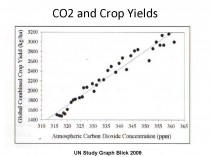
Animal products are also of course an important component of the diet in the industrialised world, and pastoralism remains vital for many poor farming families in developing countries. Philip Thornton of the International Livestock Research Institute in Nairobi sees potential for increased productivity from breeding (including transgenics), and improved nutrition and animal health. The relative balance of arable and livestock farming is itself also an important issue, since considerably more land and water is needed to produce each kilo of animal protein.
Concerns remain about the sustainability of wild fish stocks, but John Bostock and colleagues from the University of Stirling review the growth of aquaculture (which in 2007 accounted for 43% of global fish and shellfish production) and foresee further expansion. This would be facilitated by greater use of non-carnivorous species, reducing the reliance of fishmeal for species such as salmon.
To set against this broadly positive background, Kenneth Strzepek (University of Colorado/MIT) and Brent Boehlert (Industrial Economics Inc) project an 18% reduction in the worldwide availability of water for agriculture by mid-century, with much more dramatic localised effects. This is based on climate change modelling together with increased demands for municipal and industrial water and the need not to cause environmental damage by extracting too much of the rainfall runoff.
This should come as no surprise, as water shortages have been highlighted as an issue for many years. To some extent, more efficient use of current resources via techniques such as drip irrigation may help, but these require a level of sophistication which is not available everywhere. But on a more general level, the issue is not about water per se, but about water of sufficient purity. Adaptation of crops for more saline environments could be one part of the solution. More broadly, large-scale desalination could make up the balance, given a sufficiently economic energy supply. In many areas of the Mediterranean, Tropics and sub-Tropics this could be a major use for solar power in coastal areas.
The Royal Academy of Engineering’s report covers much broader issues of water supply and management, focussing on better capture and utilisation. Addressing the issue of food production, they recommend further work on “water efficiency in agriculture through water management and drainage and improved surface irrigation alongside drought-heat tolerant crop varieties (in parallel with improvements in plant breeding or genetic manipulation to reduce irrigation demand).” They recognise the challenge, but also see that it can be tackled.
We can see that there are real challenges ahead to provide food security for a larger population by 2050, but also that these challenges are not insurmountable. In the introductory paper of the Royal Society publication, a team of distinguished authors summarises many of the findings and comes to quite a positive conclusion. To quote:
“Another theme that emerges is the importance of taking a ‘competing risks’ approach to regulation in the food system - it is too easy to close off options by applying naive versions of the precautionary principle. The world is going to have to produce more food, and unless much of the Earth’s remaining biodiversity is to be destroyed, this will need to be done without expanding the area under cultivation. Achieving higher yields from the same acreage without severely impacting the environment requires a new way of approaching food production - sustainable intensification.”
Wise words.
Aug 17, 2010
Resource Sterilisation endangers National Security
By Viv Forbes, Carbon Sense Coalition
Extreme conservation policies are sterilising so much of Australia’s resources that it is becoming a threat to our national security. Most wars are about land and resources.
In the colonial era, aggressive Europeans swarmed into Africa, the Americas and Australia attracted by underused land, minerals and timber. More recently, Hitler invaded Eastern Europe and Russia in the search for “living space” and access to Black Sea oil and Japan went to war attracted by the resources of South East Asia and Australia.
Australia is the odd man of Asia - a huge land mass with a small population. Our populous and rapidly developing northern neighbours need the primary products that Australia has in abundance - food, fibres, minerals and energy. So they note with disbelief the way in which Australia is sterilising these valuable resources.
They see precious agricultural and forest land being swallowed by National Parks, World Heritage Reservations, Environmental Parks, Wild Rivers Declarations, Indigenous reservations and bans on land clearing. Unbelievably we have nine protected Wild Rivers, 11 World Heritage properties, 516 National Parks, 2,700 designated conservation areas and huge areas of government leasehold and aboriginal land. The latest proposal is a continuous conservation corridor running from Melbourne to Atherton. In all of these areas, agricultural and mining production are prohibited or increasingly restricted.
Our neighbours look on in amazement as foresters are locked out of State Forests, water courses become no-go zones for graziers and irrigation water is withdrawn from farmers and orchardists. Soon the whole Coral Sea will be locked up and beaches made off limits to fishermen. Future Australians are in danger of becoming a nation of peasants, poachers and smugglers in their own land.
Asia needs our abundant energy resources of coal, gas, oil shale and uranium. But they watch in disbelief as uranium mining is banned, gas is wasted in power generation, mining taxes are increased and there are threats to tax carbon and close our coal mines and power stations. History has no examples where a small number of self-indulgent people have managed to squat on valuable land and idle resources forever. And our historic protectors are no longer invincible - the Royal Navy no longer controls the Indian Ocean or the South China Sea and the US Navy is no longer unchallenged in the Pacific.
Today the refugee flotilla is unarmed. If we continue sterilising our resources of land, oceans, food, minerals and energy, future fleets may not submit peacefully to Australian boarding parties.
Farming Carbon Credits
The ALP has offered to buy votes from Australian farmers with carbon credits for growing trees. Farmers would be more impressed if the ALP offered to pay for the millions of carbon credits recently stolen from them using tree clearing bans and other land use restrictions. And once all farmland is covered by carbon credit forests, what shall we eat?
More Green Energy Dreams:
Zero Carbon Australia by 2020 Plan.
A Melbourne group calling itself “Beyond Zero Emissions” has produced a plan “Zero Carbon Australia - Stationary Energy Plan”. No coal power, petrol cars, diesel trucks or air trips. (Presumably they are also going to stop exhaling by 2020).
This will be the new bible for anti-carbon energy crowd.
This plan has been evaluated by competent energy people who have revised the assumptions and cost estimates. They conclude: the ZCA2020 Stationary Energy Plan has significantly underestimated the cost and time scale required to implement such a plan. Our revised cost estimate is nearly five times higher than the estimate in the Plan: $1,709 billion compared to $370 billion. The cost estimates are highly uncertain with a range of $855 billion to $4,191 billion for our estimate.
The wholesale electricity costs would increase nearly 10 times above current costs to $500/MWh, not the $120/MWh claimed in the Plan. The total electricity demand in 2020 is expected to be 44% higher than proposed: 449 TWh compared to the 325 TWh presented in the Plan.
The Plan has inadequate reserve capacity margin to ensure network reliability remains at current levels. The total installed capacity needs to be increased by 65% above the proposed capacity in the Plan to 160 GW compared to the 97 GW used in the Plan. The Plan’s implementation timeline is unrealistic. We doubt any solar thermal plants, of the size and availability proposed in the plan, will be on line before 2020. We expect only demonstration plants will be built until there is confidence that they can be economically viable.
The Plan relies on many unsupported assumptions, which we believe are invalid; two of the most important are:
1. A quote in the Executive Summary “The Plan relies only on existing, proven, commercially available and costed technologies.”
2. Solar thermal power stations with the performance characteristics and availability of baseload power stations exist now or will in the near future.
See here and here.
The Last Word on the Election.
If the ALP/Green Coalition wins this election, carbon taxes and emissions trading will suddenly rise from the dead. Our advice remains the same:
Number every square.
Put Climate Sceptics first and the Greens last.
Make your own choices from there on, but the Nationals, some Liberals and most of the other minor parties are strongly opposed to carbon Ration-N-Tax Schemes. (We forgot to mention One Nation as another group sceptical of the idea that man’s production of carbon dioxide has harmful effects on anything.)
Aug 16, 2010
July Spot Check
By Dr. Richard Keen
Last month I sent a “spot check” of June’s measured temperature anomaly at the Coal Creek Canyon, Colorado, co-op station compared to NCDC’s analyzed temperature departure map for the month. Interpolating the NCDC map to my location gave an analyzed departure of +4F, compared to the actual station departure of only +1.0F.
Here’s July’s map from NCDC’s site.
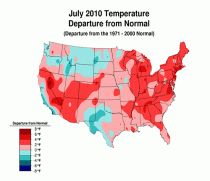
On the map, Coal Creek Canyon is above the 2F contour, with an analyzed departure of about 2.5 or 3 degrees F. And the actual observed departure? +0.3 degrees F. Once again, NCDC adds 2 or 3 degrees to the observed temperature anomaly.
Could it just be this one station? No, since another mountain site with a long record about 15 miles to my north (Jamestown) had a monthly departure of -0.5F (yes, Minus). And the Denver airport site had +1.0F.
The NOAA headlines announce this as the 2nd warmest July on record nationally, but at Coal Creek July came in 12th place, out of 28 years of record. July 2003 was 6 degrees warmer than this past July, and July 1992 (the year after Pinatubo) was 4 degrees cooler.
I’ll keep checking this in future months, but I suspect the story will remain the same, with mystery adjustments inflating the temperature departures in one direction only.
----------------
Mid-Season Update on the 2010 Hurricane Season
By Joseph D’Aleo
Both Drs. Gray and Klotzbach and NOAA and many in private industry have been (still are) predicting a very active Atlantic tropical season. Dry, dusty Saharan air and a confused pressure and upper air pattern has limited activity to date. But usually in summers after El Nino winters with a warm Atlantic, activity does increase especially after mid-August. We may not reach the lofty levels of some early forecasts the pressure patterns are not yet ideal but don’t write off the season just yet as Dr Klotzback opined here.
Update: See Dr. Lupo’s take on the early season here.
Since 1995, the Atlantic has become twice as active on average as the prior 25 years, similar to the period from 1930s to 1960s. This is due to a shift to the “warm” mode of the multi-decadal scale oscillation in the Atlantic Ocean. Most of the storms making landfall since 1995 have impacted the Mid-Atlantic region, Florida and the Gulf of Mexico. However, though not yet realized, history tells us that the risk has also increased for more populated areas to the north (Long Island and New England) (below, enlarged here and here).
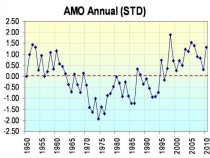
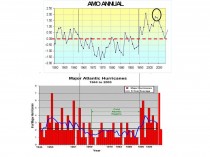
Note the increase in the number of stronger storms after the flip back to the warm mode in 1995 (below, enlarged here and here).
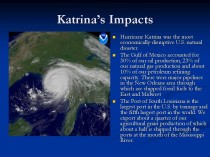
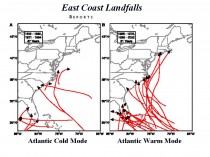
Bill Gray has shown the number of land falling storms along the southeast coast increases in the warm mode (above). The same can be said for the Atlantic coast in general as shown below (enlarged here).
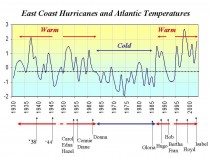
Those that survive, often recurve out to sea or escape the shear by taking a more southern route through the Caribbean to the Gulf, where most make landfall.
The landfall depends on the strength and position of the Bermuda High in the Atlantic. A tropical system will tend to turn north at first opportunity including a weakness in the Bermuda high. The stronger and farther west the high extends, the further west the storm moves before turning or landfall (enlarged here).
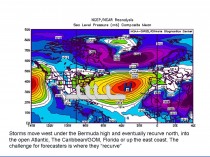
El Ninos tend to produce fewer storms by increasing the shear in the Atlantic, fed by increased Pacific tropical activity (enlarged here).
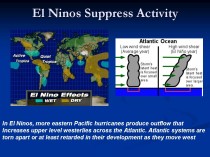
Those that survive often recurve out to sea or escape the shear by taking a more southern route through the Caribbean to the Gulf, where most make landfall (enlarged here).
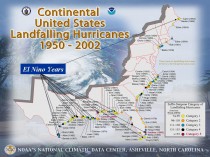
La Ninas on the other hand show less shear, more storms and more landfalls. Weakness of pressure along the east coast favors more landfalls (enlarged here).
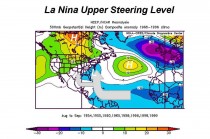
See the widepread spray of storms in La Nina late summers and fall (enlarged here).
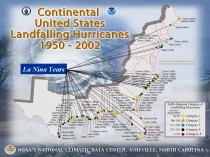
The La Nina landfalls are in the Gulf, Southeast Coast and the Northeast/New England.
THE EFFECT OF THE PACIFIC DECADAL OSCILLATION
The PDO affects the relative frequency of the El Nino and La Nina. We turned to the colder mode of the PDO in the late 1990s, which tends to mean more La Ninas like the last cold mode 1947 to 1977 (enlarged here).
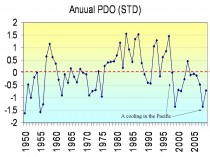
See clearly the ENSO frequency shift with the PDO phases (enlarged here).
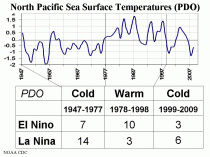
The area of the east coast north of Cape Hatteras risk is greatest during La Nina years when the PDO is negative and the Atlantic is warm (this summer!)
See how New England landfalls vary with the PDO (enlarged here).
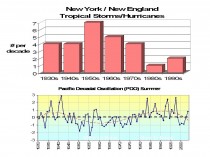
La Nina Years Occurring with Warm Atlantic Summers
* 1938 Hurricane of ‘38 (CAT 5) New York and New England
* 1950 Hurricane Easy (CAT 3) Florida, Hurricane King (CAT 3) Florida
* 1954 Hurricane Carol (CAT 3) New York and New England, Hurricane Edna (CAT 3) New England, Hurricane Hazel (CAT 4) Mid-Atlantic and northeast
* 1955 Hurricane Connie (CAT 3) NC, VA, NY, New England Flooding, Hurricane Diane (Cat 1) NC, New England Flooding
* 1960 Hurricane Donna (CAT 4) FL, (CAT 3) NY, New England
* 1989 Hurricane Hugo (CAT 4) SC
* 1996 Hurricane Bertha (CAT 2) NC, Hurricane Fran (CAT 3) NC
* 1998 Hurricane Bonnie (CAT 2) NC
* 1999 Hurricane Floyd (CAT 2/3) NC
15 landfalling storms in the 9 years!!!!! 11 major hurricanes. 9 affected northeast
HOW THE TROPICAL ATLANTIC WARMED
Some of the warmth was due to a lack of activity last hurricane season. Hurricanes act to extract excess tropical ocean warmth (in the form of sensible and latent heat) and transfer it poleward (one of the compensation mechanisms that bring about equilibrium). Ironically also the result of the record negative AO and very cold Northern Hemisphere winter in the southern US, Europe, Russia, China. A record negative AO suppressed jet streams and subtropical highs in both oceans (enlarged here).
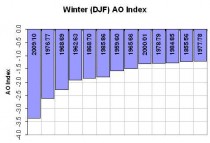
Lower wind speeds and reduced cloudiness due to subsidence in the deep subtropics led to warm water near the surface (bottom right) (enlarged here).

The very latest Atlantic sea surface temperature analysis from the Hurricane Center showing the warm water that will help feed the activity (enlarged here).
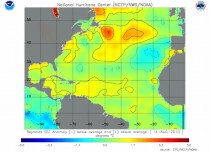
So all along the Gulf and East Coast should remain wary and watchful the next few months and not be lulled to a false sense of security by the deafening quiet this season thus far. Thought the cuurent conditions with an unfavorable Madden Julian Oscillation, a confused upper pattern and dry and dusty air patches are still impeding development, that is likely to change. Even if we end up at the lower end of the range of the forecast number of storms, one major landfall would make for a memorable season (as the Hurricane of ‘38). See preliminary late May post here.
See Accuweather’s Joe Bastardi’s forecast here.
Aug 16, 2010
Tropical sea surface temperatures respond to natural changes in surface pressure across the globe
By Erl Happ
Tropical sea surface temperatures respond to the change in surface pressure across the globe and in particular to the differential between mid latitudes and the near equatorial zone. The southern hemisphere and high latitudes in particular experience marked flux in surface pressure. This leads directly to a change in the trade winds and tropical sea surface temperature.
There is an asymmetry between the hemispheres with loss of pressure in the southern hemisphere compensated to some extent by a gain in pressure in the northern hemisphere.
If we wish to understand the ENSO phenomenon we must look beyond the tropics for causal factors. ENSO in the Pacific is just one facet of change in the tropics. Change is driven by air pressure variations at mid and especially high latitudes. This determines the strength of the trade winds and the temperature of the tropical ocean (where solar insolation is greatest and cloud cover is least). There are knock on effects for heat transfer from the tropics to mid and high latitudes, rainfall, flood, drought and tropical cyclone activity worldwide. The tropical oceans represent the Earths solar array.
The flux in surface pressure appears to be cyclical. However, the cycle is longer than the sixty years of available data. We cannot say for sure what the cycle length may be or how it varies over time. However, there is good evidence that the warming cycle that began in 1978 peaked in 1998 is now at an end.
We must acknowledge that the ENSO cycle is not temperature neutral. There are short ENSO cycles of just a few years and long ENSO cycles that are longer than 60 years (enlarged here).

Is there evidence that the activity of man (adding CO2 to the atmosphere) is tending to produce more severe El Nino events. The answer is no. The flux in surface pressure is responsible for ENSO and for the swing from El Nino to La Nina dominance. In spite the activities of man, the globe is currently entering a La Nina cooling cycle testifying to the strength of natural cycles and the relative unimportance atmospheric composition in determining the issue (if the much touted greenhouse effect exists at all) .
Is there evidence that the ENSO phenomenon is in fact ‘climate change in action’, driven by factors other than the increase of atmospheric CO2? Yes, it appears that whatever drives the flux in surface atmospheric pressure drives ENSO and with it, climate change.
Is recent ‘Climate Change’ driven by greenhouse gas activity? No, it appears that the cause of recent warming and cooling relates to long-term swings in atmospheric pressure that changes the pressure relations between mid and low latitudes thereby affecting the trade winds that in turn determine the temperature of the Earth’s solar array, its tropical ocean, and ultimately the globe as a whole.
|




















